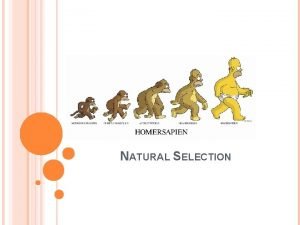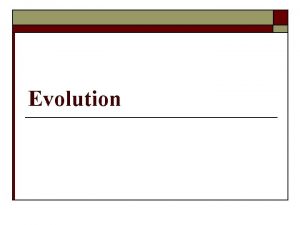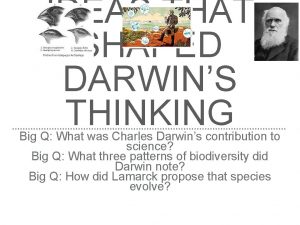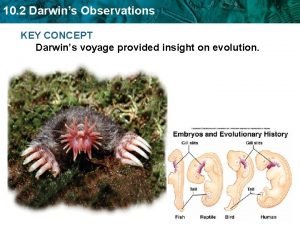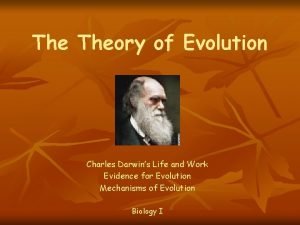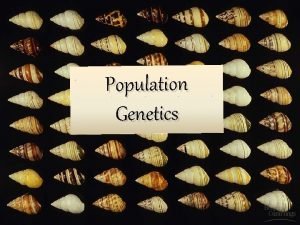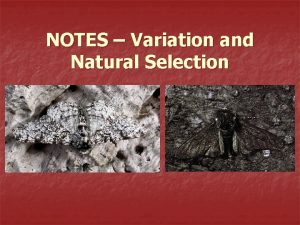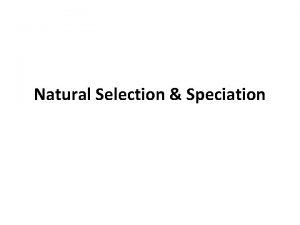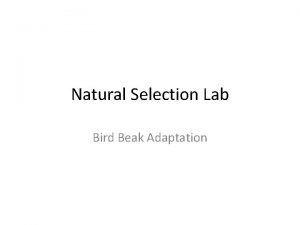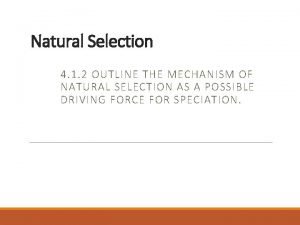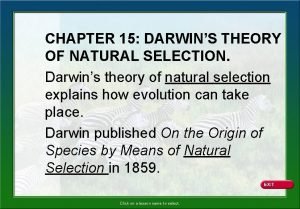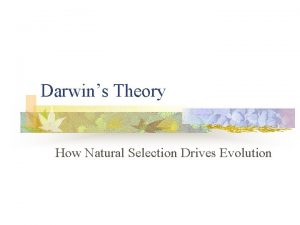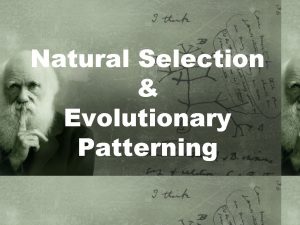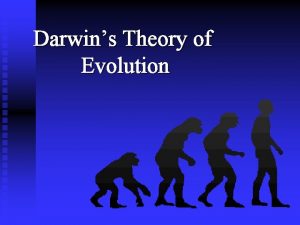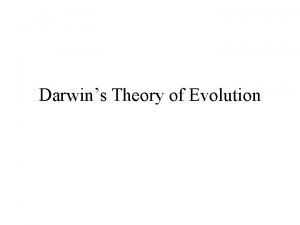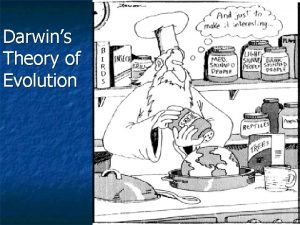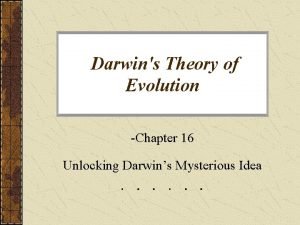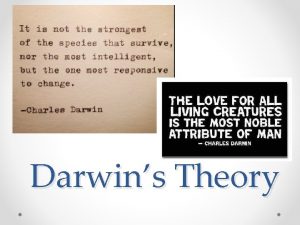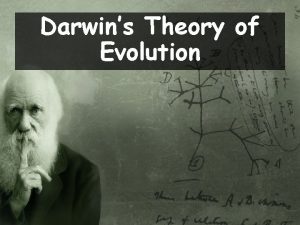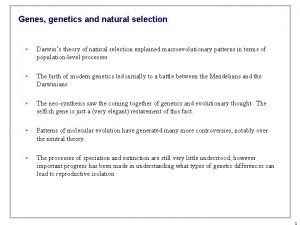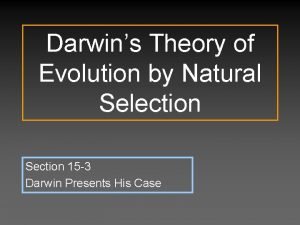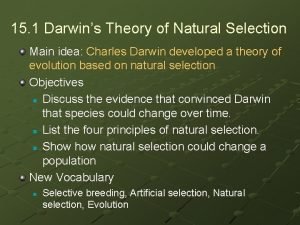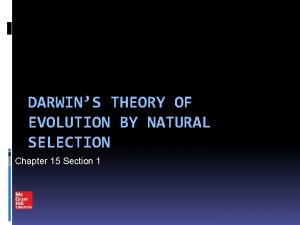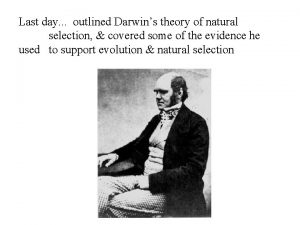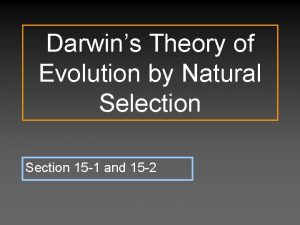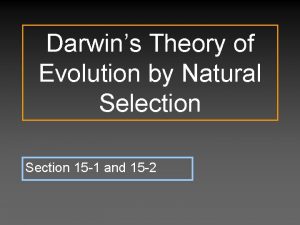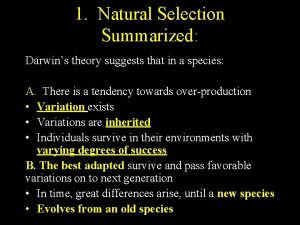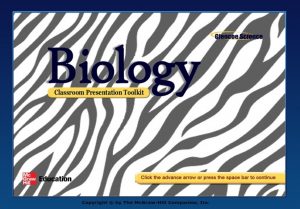Darwins theory of natural selection Population grow exponentially













































- Slides: 45

Darwin’s theory of natural selection: • Population grow exponentially • Over population results in competition and struggle for existence • In any population, there is unequal abilities for individuals • Only the best fit survive and pass their traits • Evolution occurs when advantageous traits accumulate in a population Please see video

Figure 17. 15

Figure 17. 16

Figure 17. 17


Condition for Hardy – Weinberg equation: 1. Large population 2. No evolution: Population is stabilized, in equilibrium • • • No genetic drift No gene flow No mutation No non-random mating No natural selection



Cause of Evolution • Genetic drift – Bottle neck effect – Founder’s effect • • Gene flow Mutation Non-random mating Natural selection








Habitat isolation: Two species of Garter snake Thamophis Terrestrial Water

Temporal isolation: Spotted skunk S. gracilis mates in summer S. putorius mates in winter

Behavioral isolation Blue-footed boobies Please see video

Mechanical isolation Monkey flower Mimulus

Gametic isolation

Reduced hybrid viability Salamander Ensatina

Reduced hybrid fertility

Hybrid breakdown







22 9




Types of Evolution • • Directional Diversifying Stabilizing Heterozygotic supriority • Minority advantage • • • Divergent Convergent Parallel Reciprocal Adaptive radiation

Figure 18. 6

Figure 18. 2

http: //www. faceresearch. org/demos/average (Works when in slide show)

1930. JBS Haldane Heterozygotic superiority SS ss Ss Sickle cell anemia Normal Disease Normal Malaria S R R

Australian Mole North American Mole





The same evolutionary forces acted on humans
 Chapter 15 section 1 darwins theory of natural selection
Chapter 15 section 1 darwins theory of natural selection Chapter 17 darwin's theory of evolution
Chapter 17 darwin's theory of evolution Darwin's hypothesis
Darwin's hypothesis Similarities
Similarities Natural selection vs artificial selection
Natural selection vs artificial selection Artificial selection vs natural selection
Artificial selection vs natural selection Directional selection example
Directional selection example Natural selection vs artificial selection
Natural selection vs artificial selection Exponentially weighted average
Exponentially weighted average Can a population grow indefinitely
Can a population grow indefinitely Who formulated theory of evolution? *
Who formulated theory of evolution? * Jaguar natural selection
Jaguar natural selection Whats the theory of natural selection
Whats the theory of natural selection Theory of natural selection
Theory of natural selection Section 15-2 ideas that shaped darwin's thinking
Section 15-2 ideas that shaped darwin's thinking Section 15-2 ideas that shaped darwins thinking
Section 15-2 ideas that shaped darwins thinking Section 2 darwins observations study guide a
Section 2 darwins observations study guide a Lesson 2: ideas that shaped darwins thinking
Lesson 2: ideas that shaped darwins thinking Species vary locally
Species vary locally Ideas that shaped darwin's thinking answer key
Ideas that shaped darwin's thinking answer key Lesson 1 a voyage of discovery
Lesson 1 a voyage of discovery Darwins observations
Darwins observations Chapter 4 population ecology test answer key
Chapter 4 population ecology test answer key Section 1 population dynamics answer key
Section 1 population dynamics answer key Population ecology section 1 population dynamics
Population ecology section 1 population dynamics Chapter 4 section 1 population dynamics
Chapter 4 section 1 population dynamics Balancing selection vs stabilizing selection
Balancing selection vs stabilizing selection K selection r selection
K selection r selection What is exponential growth in ecology
What is exponential growth in ecology Two way selection and multiway selection in c
Two way selection and multiway selection in c Multiway selection
Multiway selection Mass selection and pure line selection
Mass selection and pure line selection Natural resources and population growth
Natural resources and population growth P**n
P**n 4 principles of natural selection
4 principles of natural selection Stabilizing selection definition
Stabilizing selection definition Genetic drift
Genetic drift Types of natural selection
Types of natural selection Aids basketball player
Aids basketball player 3 types of natural selection
3 types of natural selection Bird beak adaptation lab
Bird beak adaptation lab 3 types of natural selection
3 types of natural selection Natural selection definition
Natural selection definition Natural selection in cats
Natural selection in cats Homologous structures
Homologous structures Ted ed evolution
Ted ed evolution
